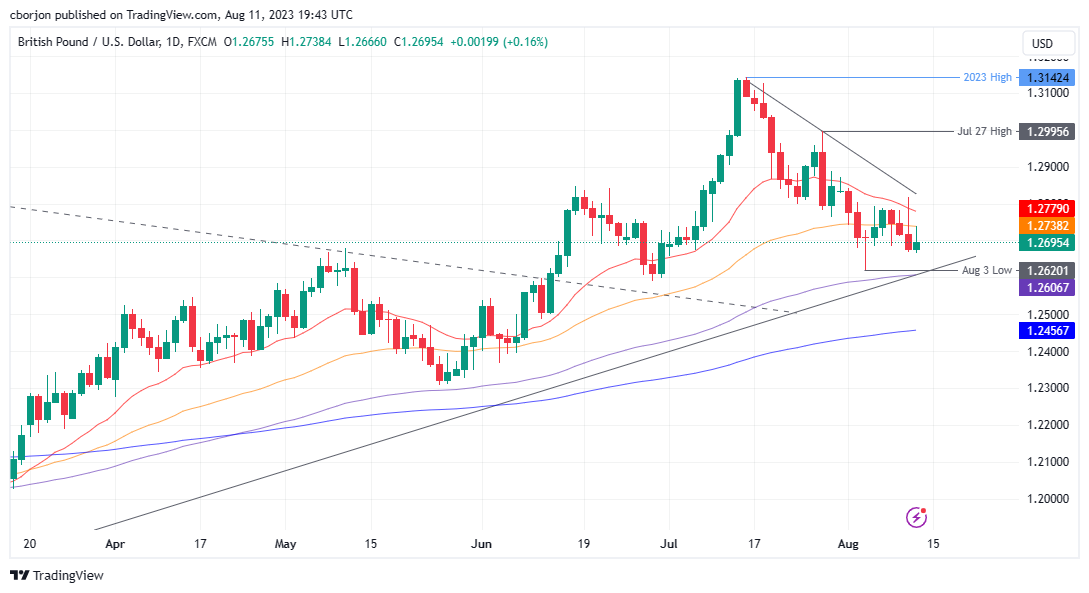- The US Producer Price Index (PPI) is higher than in June, prompting a temporary recovery in the Dollar and a fall in GBP/USD.
- A University of Michigan poll shows optimism about declining inflation after the Fed’s 525 basis point rate hike.
- The British economy beats forecasts, reinforcing the Bank of England’s stance on raising interest rates amid fears of recession.
Late in the New York session, the British Pound (GBP) continued to hold against the US Dollar (USD) after the UK economy grew more than expected, despite high US inflation on the producer side. . Thus, the GBP/USD pair is trading at 1.2697, with a gain of 0.16%.
Wall Street reels after mixed US inflation data with unexpected UK economic rebound
Wall Street will end the session with losses after inflation data from the United States (US) returned mixed results. Consumer inflation rose above the previous month but below estimates, sparking speculation that the Federal Reserve (Fed) might end its tightening cycle, but Friday’s data changed the opinion to investors.
The US Department of Labor showed that the prices paid by producers, known as the Producer Price Index (PPI), exceeded June readings, spurring a recovery in the Dollar; consequently, GBP/USD weakened.
The University of Michigan Consumer Sentiment Survey revealed that US consumer sentiment deteriorated slightly. Still, Americans remained positive about lower inflation after the US Federal Reserve (Fed) raised its borrowing costs by 525bp, with inflation expected to fall below 3 % over a five-year horizon.
Across the Atlantic, the UK economy grew surprisingly above estimates, justifying the Bank of England’s (BoE) need to raise rates amid stubbornly high inflation. However, next week’s inflation data may serve as a lifeline for the BoE if it shows signs of slowing as the UK economy remains on the brink of recession.
GBP/USD Price Analysis: Technical Perspective

GBP/USD’s break to a new weekly high above 1.2800, but reversing its gains after weak US inflation data, has exacerbated GBP/USD’s pullback, extending below the 1.2700 mark. . If GBP/USD sustains below the latter and achieves a daily close, faith in the British Pound (GBP) would be consolidated. That being said, GBP/USD’s first support would emerge at 1.2666, followed by the August 3 daily low at 1.2620, before falling towards 1.2500. Conversely, if GBP/USD buyers recover to 1.2700, they would be encouraged by buyers who may hold out hope of reaching 1.2800 before challenging the July 27 daily high at 1.2995.
GBP/USD
| Overview | |
|---|---|
| Last price today | 1.2695 |
| daily change today | 0.0019 |
| today’s daily variation | 0.15 |
| today’s daily opening | 1.2676 |
| Trends | |
|---|---|
| daily SMA20 | 1.2844 |
| daily SMA50 | 1,276 |
| daily SMA100 | 1.2604 |
| daily SMA200 | 1.2344 |
| levels | |
|---|---|
| previous daily high | 1.2819 |
| previous daily low | 1,267 |
| Previous Weekly High | 1.2873 |
| previous weekly low | 1.2621 |
| Previous Monthly High | 1.3142 |
| Previous monthly minimum | 1.2659 |
| Fibonacci daily 38.2 | 1.2727 |
| Fibonacci 61.8% daily | 1.2762 |
| Daily Pivot Point S1 | 1.2624 |
| Daily Pivot Point S2 | 1.2573 |
| Daily Pivot Point S3 | 1.2475 |
| Daily Pivot Point R1 | 1.2773 |
| Daily Pivot Point R2 | 1.2871 |
| Daily Pivot Point R3 | 1.2922 |
Source: Fx Street
I am Joshua Winder, a senior-level journalist and editor at World Stock Market. I specialize in covering news related to the stock market and economic trends. With more than 8 years of experience in this field, I have become an expert in financial reporting.







